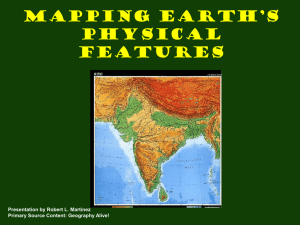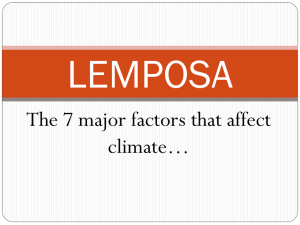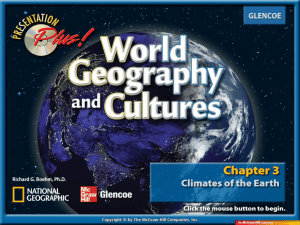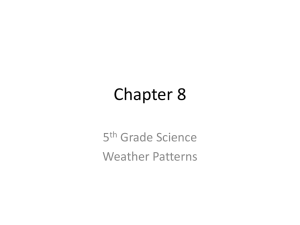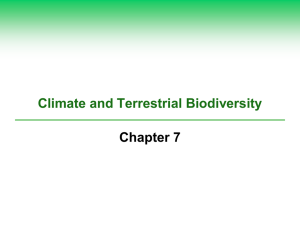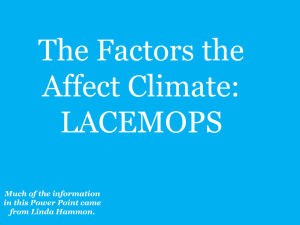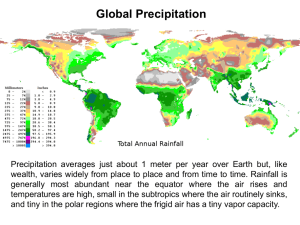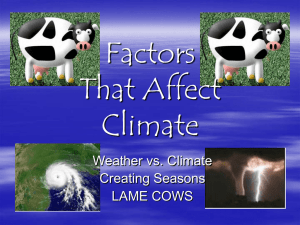Chapter 18: Climate and Climate Change, 18
advertisement
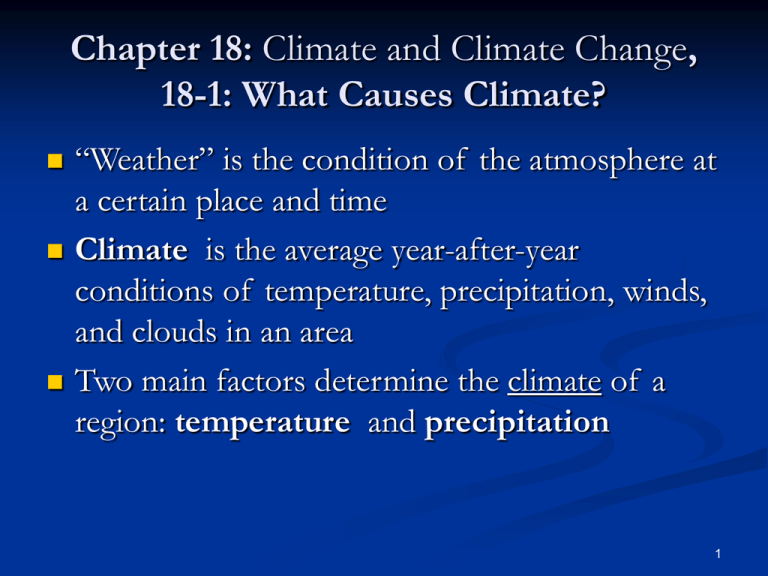
Chapter 18: Climate and Climate Change, 18-1: What Causes Climate? “Weather” is the condition of the atmosphere at a certain place and time Climate is the average year-after-year conditions of temperature, precipitation, winds, and clouds in an area Two main factors determine the climate of a region: temperature and precipitation 1 18-1 Factors affecting temperature The main factors that influence temperature are latitude, altitude, distance from large bodies of water, and ocean currents. Latitude is the distance from the equator, measured in degrees. Climates of areas farther from the equator tend to be cooler than areas close to the equator. 2 18-1 Factors affecting temperature: Latitude Earth’s temperature zones based on latitude • Tropical zone: Near the equator, between 23.5° North and 23.5° South, climates are warm. Frequent direct sunlight • Temperate zones: Between tropical and polar zones (23.5°-66.5°North, and also 23.5°66.5°South). Climates in these areas vary from having warm or hot summers to having cool or cold winters • Polar zones: Near poles, from 66.5° to 90° North and from 66.5° to 90° South, climates are cold 3 Climate Zones http://www.cgrove417.org/fry/Science/Climate/climate%20graphics/Climatezones.jpg 4 Climate Zones http://www.iteachbio.com/Life%20Science/Ecology/ClimateZones.png 5 18-1Factors affecting temperature Altitude • The temperature of the troposphere decreases about 6.5° Celsius for every 1kilometer increase in altitude. *Highland areas everywhere have cool climates * Mount Kilimanjaro is 39° Celsius cooler at it’s peak than the air at sea level at the same latitude 6 Mount Kilamanjaro http://www.destination360.com/africa/tanzania/images/s/mount-kilimanjaro.jpg 7 18-1 Factors affecting temperature: Distance from large bodies of water • Oceans or large lakes can affect temperatures • Oceans/large lakes moderate (make less • • • extreme) temperatures of nearby land Water heats up more slowly and cools down more slowly than land Winds from the ocean keep coastal areas from reaching extreme temperatures Marine climates have warm winters and cool summers 8 18-1 Factors affecting temperature: Ocean currents • Mary marine climates are influenced by ocean currents • Generally, warm currents from tropics carry warm water toward poles while cold currents from poles carry cold water towards the equator • The air over these currents is warmed or cooled and affects the land nearby 9 Gulf Stream & Europe http://www.johnchaple.co.uk/images/le-gulf-stream.jpg 10 Global Average Temperatures http://www.climate-charts.com/images/world-temperature-map.png 11 18-1 Factors affecting Precipitation • The main factors that affect precipitation are prevailing winds and the presence of mountains. • Air masses are moved by prevailing winds. The characteristics of the air in an air mass will determine how much rain or snow can fall. • Prevailing westerlies air masses across the United States. 12 18-1 Factors affecting precipitation: Mountain Ranges • A mountain range in the path of prevailing winds can influence where precipitation falls * When humid winds blow from the ocean toward a mountain range the air is forced to rise up to pass the mountains. The warm humid air cools and condenses this forms clouds and maybe rain or snow 13 Eisenhower Tunnel in Colorado p://images.travelpod.com/users/chmk11/1.1263678962.i---70-entering-eisenhower-tunnel.jpg 14 Eisenhower Tunnel in Colorado 15 http://images.travelpod.com/users/chmk11/1.1263678962.the-easy-route-is-boring.jpg Sierra Nevada Mountains http://www.atmos.umd.edu/~dankd/MesDes3/images/SierraNevada5.jpg 16 17 18-1 Factors affecting precipitation: Mountain Ranges • Rain or snow tends to fall on the windward side of the mountain, the side that oncoming wind hits • The leeward side of the mountain which is downwind from the windward side is in a “rain shadow”. The air on the leeward side tends to be drier than the windward side where the rain or snow falls, after being removed from the humid wind 18 18-1 Microclimates A microclimate is a small area with specific climate conditions that may be different from the surrounding area Inland mountains, lakes, forests, and other natural features can influence the climate nearby, resulting in a microclimate 19 Global AverageTemperatures http://www.climate-charts.com/images/world-temperature-map.png 20 18-1 Seasons Most places on Earth outside of the tropics have four seasons: winter, spring, summer and autumn The seasons are caused by the tilt of Earth’s axis as Earth travels around the sun. Earth is tilted at an angle of 23.5° on its axis. 21
